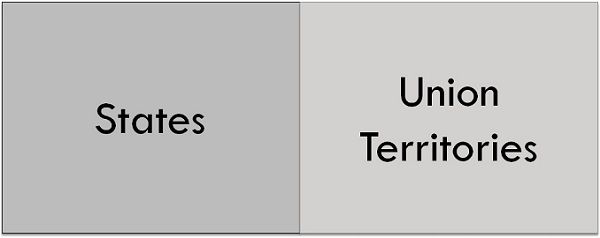 The state can be understood as the constituent division, which possesses a separate government. Conversely, Union Territory is a small administrative unit, that is ruled by the Union. India, a country located in the South Asia, is among the largest country in the world. It is a federal country, i.e. here the power is distributed among the central and various units. When it comes to administrative divisions of the country, after the inclusion of Telangana there are total 29 states and 7 Union Territories.
The state can be understood as the constituent division, which possesses a separate government. Conversely, Union Territory is a small administrative unit, that is ruled by the Union. India, a country located in the South Asia, is among the largest country in the world. It is a federal country, i.e. here the power is distributed among the central and various units. When it comes to administrative divisions of the country, after the inclusion of Telangana there are total 29 states and 7 Union Territories.
In India, all the states and two union territories, i.e. Puducherry and Delhi possess elected legislature and government. The rest of the Union Territories are controlled and administered directly by the Central Government. These states and union territories are further classified into districts, which are sub-divided into tehsils. Most people lack understanding on the difference between State and Union Territory.
Content: State Vs Union Territory
Comparison Chart
| Basis for Comparison | State | Union Territory |
|---|---|---|
| Meaning | State is defined as the administrative units with their own elected government. | Union Territory implies the constituent units, that are controlled and administered by the Central Government. |
| Relationship with center | Federal | Unitary |
| Head of Executive | Governor | President |
| Administered by | Chief Minister, elected by the people. | Administrator, appointed by President. |
| Area | Large | Small |
| Autonomy | Yes | No |
About States
States are explained as the administrative unit, that has its elected government, which has the right to frame its laws. It has its own Legislative Assembly and the Chief Minister, for administration. The Governor acts as the representative of the President, in states. There is a distribution of sovereign legislative and executive powers between the Centre and state, regarding the territory of that state.
Different states vary in size, demography, history, dressing style, culture, language, tradition and so on. Prior to independence, there were two kinds of states in India, i.e. Provinces and Princely states, wherein provinces are under the control of British Government while the Princely states are ruled by the hereditary rulers. However, there is no such classification in states today.
About Union Territories
In India, Union Territories are the constituent division which enjoys very less power but has special rights and status. These are governed directly by the Central Government. The administrator or the Lieutenant Governor is appointed as a representative, by the President of India.
There are total seven union territories in India, out of which 2, i.e. Delhi and Puducherry, have their elected members and the Chief Minister, as these are granted with partial statehood, by amendment to the Constitution. These two possess their own legislative assembly and executive council and operate like states. The remaining union territories are controlled and regulated by the Union of the country, that’s why named as a union territory.
Key Differences Between State and Union Territory
The differences between state and union territory are explained in the points provided below:
- State refer to the administrative division, which has their own elected government. On the contrary, Union Territory is an administrative unit that is controlled and regulated by the Union Government.
- States have a federal relationship with the Central Government, wherein the sovereign legislative and executive powers are distributed between state and union, concerning the state, whereas Union Territory has a unitary relationship with the Central Government, i.e. all the powers rests in the hands of the Union.
- The constitutional head of the state is the governor of the state. As against this, President is the executive head of the union territory.
- States are administered by Chief Minister, elected by the people. On the flip side, Union Territories are administered by Administrator, who is appointed by President.
- The area of the state is comparatively larger than that of the union territory.
- States possess autonomy, while union territory doesn’t.
Conclusion
To preserve the cultural heritage and to better manage the affairs, India is divided into various States and Union Territories. All the states and union territories in India follow different cultures, traditions, customs, history and language. The size of union territory is very small in comparison to a state.






nagaratana says
very simple and informative
jack songs says
This is very useful post for me. This will absolutely going to help me in my project.